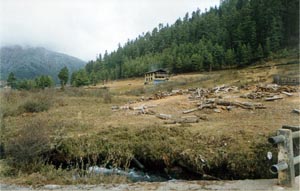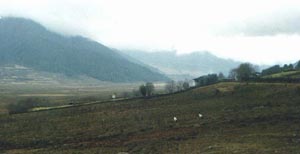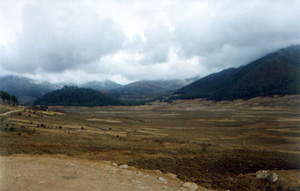|
Travelogues Bhutan: The Last Shangri-La
|
||||||||||||||
My 14 year old daughter, Tania, looked at me in obvious bewilderment when I mentioned Phobjika. A small photo in the Lonely Planet guide to Bhutan showed a traditional Bhutanese home in the foreground of a valley. This photo somehow piqued my desire to be where the photographer stood.
Bhutan, other than Thimpu and Paro, is a difficult destination for Indians, particularly in winter. That is the time when Black-necked cranes come to nest in the swampy valley. I eventually got to watch them from the very house I had looked at with so much yearning.
|
More on Bhutan • Overview • Places to Visit • FAQ
Travelogues
Photo Gallery | |||||||||||||
Bhutan beyond Thimpu and Paro is restricted to all foreigners including Indians. Travel agents normally take care of permits for tourists on a package tour. Even for individual tourists it is not too much of a hassle. We landed at the Thimpu Dzong around 10:30 am and went to the Immigration counter. We had to fill up a small form mentioning the areas we intended visiting and submittedit along with the original entry permit that was issued at Phuentsholing (Strangely the permit showed Tania as the tourist and poor me accompanying her). We were told to collect the permit at 3pm.
We started around 8am from Thimpu. The road winds up to Dochu La (3150m) through thick forests of blue pine and apple orchards. Bhutan seems to be paranoid about foreigners and has an immigration check post every 50kms. There was one just below the Dochu La and I reluctantly came out of the relative comfort of the car to show my permit before crossing the Pass. Thick clouds were all around us and we had little hope of the brilliant views promised in Lonely Planet. There is a café on top of the pass and we climbed there to find it closed for the winter. A giant binocular could be seen inside and I tried to imagine the view on a clear day, sitting inside the café with a hot cup of coffee in hand. We met a couple from New Zealand at Paro, both working for the UN in Thimpu for 3 years who had been through the pass countless times without seeing anything! The real fun began as we started descending from the pass. The road was snow covered and a 4 – wheel drive Toyota pick up, just ahead of our Omni, braked and started sliding sideways without any control. A pillar built by Indian Border Roads organization ‘Dantak’ saved a tragedy. Gyambo told us to get down and start walking. We merrily obliged and got out with the camera and cash bag while he drove on (or more rightly, slid on) at snails pace. About 2 kms further down,we boarded the vehicle again and descended to the wonderful Punakha valley.
We reached a small settlement called Nobding and the final climb to the pass started. The volume of snow was increasing with every turn of the road but our Omni was going steadily enough for us to relax and enjoy the sylvan surroundings. It was a monochromatic view and looked very pure … the kind of scenery that cleanses your soul of all the accumulated urban muck. We reached a tri – junction where one road leads to the pass proper and the other to our Phobjika. The unpaved road and ice was indeed a friendly combination for vehicles. At the top, flakes of snow danced down through the swirling mist providing the only movement. Gyambo switched off the engine and we dutifully took out our cameras. In the stillness, the sound of the clicking shutter was like a sailor whistling at a virgin. There was a small chorten and just beyond that one of the most amazing mountain views greeted us. The road ran almost straight along a ridge forming a small angle with another ridge to end almost simultaneously at the floors of Phobjika Valley.
Dusk was settling in and we made ourselves comfortable in the lounge with a big bukhari (wood burning stove) providing adequate warmth. A little later the owner’s daughter Dishen called us over to the chapel where the evening prayers were being held. There were about 10 lamas, all looking very serious, but friendly. Dishen told me that I could take photos of the lamas but not the alter. The chanting continued more as a monotonous drone to rise to a crescendo accompanied by the blowing of trumpets and clashing of cymbals which again calmed down to that same drone. We had dinner and headed for bed. The room felt as if snow were hanging in the air, so we elected to snuggle into our sleeping bags and stretch out on the sofas in the lounge. The weather showed no sign of improvement in the morning. It had snowed throughout the night and the valley looked beautiful. We came out of the house and saw the first pair of Black necked cranes. The locals call them Thrung Thrung. Only about 5000 of this rare and endangered species exist in the world. We however missed their elaborate mating ritual. Phobjika is too beautiful for one visit. Got to come back once more, may be the weather will be better, may be the roads will be clearer and with a bit of luck, may be the cranes will dance …
|
||||||||||||||
Editor: Romola Butalia (c) India Travelogue. All rights reserved. |
||||||||||||||

 Somebody knocked at my hotel door around 8pm. Gyambo is an employee of Bhutan Mining Corporation and a part time taxi driver. He was in the crowd and was willing to go to Phobjika for Rs1200/- per day. His Maruti Omni was just 6 months old and instead of the tyres his vehicle was shining. I said chalo!!.
Somebody knocked at my hotel door around 8pm. Gyambo is an employee of Bhutan Mining Corporation and a part time taxi driver. He was in the crowd and was willing to go to Phobjika for Rs1200/- per day. His Maruti Omni was just 6 months old and instead of the tyres his vehicle was shining. I said chalo!!.
 A little ahead of Wangdi, the road started climbing towards Pele La (3400 m). There is practically no habitation in this part of the road except scattered houses on the hillside. The memories of Dochu La were still fresh in mind and I tentatively enquired from Gyambo about the road condition ahead. Gyambo answered confidently that the road near the pass is not paved so it should provide good grip even under snow.
A little ahead of Wangdi, the road started climbing towards Pele La (3400 m). There is practically no habitation in this part of the road except scattered houses on the hillside. The memories of Dochu La were still fresh in mind and I tentatively enquired from Gyambo about the road condition ahead. Gyambo answered confidently that the road near the pass is not paved so it should provide good grip even under snow.
 We asked for directions and climbed past a few houses to reach Phuntsho Chholing (Phuntsholing) – a massive house of teak and mud, painted in brilliant earthen colours. Our van stopped near the fence and we entered a large compound. A young boy came out and looked perplexed … this was not exactly the time for tourists. The guest house is a three storied affair and rooms are available on the 1st and 2nd floors. Guests share a common toilet and there is a large dining room cum lounge with sofas on the second floor. Incidentally that is the only room in the building that is heated. Our room was on the 2nd floor, no carpets but clean sheets, warm blankets and a wonderful view of the valley but without any heating the room didn’t quite look inviting. Tobgey, our host, explained that the family chapel is just across our room and we might be disturbed by the sounds of constant chanting, drum beats, cymbals, trumpets. We were transported back a few centuries and were enjoying every moment, except the cold, which was chilling our bones. Govt. of Bhutan has spared Phobjika from electricity and telephone lines so that the flight paths of the cranes are not disturbed.
We asked for directions and climbed past a few houses to reach Phuntsho Chholing (Phuntsholing) – a massive house of teak and mud, painted in brilliant earthen colours. Our van stopped near the fence and we entered a large compound. A young boy came out and looked perplexed … this was not exactly the time for tourists. The guest house is a three storied affair and rooms are available on the 1st and 2nd floors. Guests share a common toilet and there is a large dining room cum lounge with sofas on the second floor. Incidentally that is the only room in the building that is heated. Our room was on the 2nd floor, no carpets but clean sheets, warm blankets and a wonderful view of the valley but without any heating the room didn’t quite look inviting. Tobgey, our host, explained that the family chapel is just across our room and we might be disturbed by the sounds of constant chanting, drum beats, cymbals, trumpets. We were transported back a few centuries and were enjoying every moment, except the cold, which was chilling our bones. Govt. of Bhutan has spared Phobjika from electricity and telephone lines so that the flight paths of the cranes are not disturbed.